| Working on Sunday |
|---|
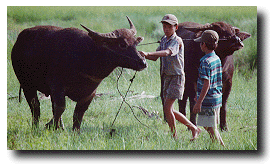 |
Both expats at his work had been to Vietnam and both had been robbed. In fact, rumor had it that Stephen Meyer was mugged in broad daylight. Meanwhile, the Lonely Planet Travel Guide for Vietnam warned that it is "not unusual for an Asian woman traveling with a Caucasian man to be called a prostitute at best and be stoned at worst.
However, they had also heard that Vietnam is one of the last remaining vestiges of pre-N.I.C. South East Asia and that travelling there was a fantastic, but with the recent economic liberalization, fleeting opportunity.
If they wanted to see traditional Vietnam, they had heard, they'd better do it soon.
He sat in a drenched EFF T-shirt, slouched over the antique wood writing table, carefully positioned to take the most advantage of the straining air-con while
| Biker Chick |
|---|
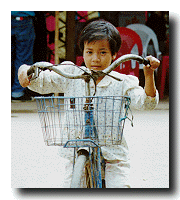 |
maintaining a peaceful view of the Mekong River quietly making its way through the delta on its way to the South China Sea.
It was really his first moment of pause since arriving at the Saigon landing strip. He hesitated to call it an airport because though it did host a number of international flights, it seemed more like a Greyhound Bus station than anything else.
Customs was a breeze as his was the only arriving flight at the moment and since he only carried one backpack. So he quickly made his way to the main terminal to meet Soy.
As it turned out, there was no main terminal. The sliding doors beyond customs opened directly onto the street. Or to rephrase that, the sliding glass doors opened directly into a frenzied orgy of local touts and cabbies pouncing on the mostly bewildered travelers who quickly grabbed their luggage with intense dedication.
| Morning Chores |
|---|
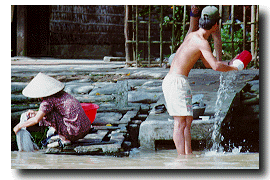 |
Fortunately, he spotted Soy in the crowd immediately and they both found the driver who they'd arranged for in advance.
His cyber-buddy and fellow South East Asian backpacker, Michael Hines, had offered him this excellent gem of advice, "Arrange transportation before arrival or know 'exactly' where you want to go. You may think that you've dealt with ferocious touts before, but you won't be able to say that until after you've negotiated the Saigon airport."
So he and Soy had decided to call ahead to several travel agencies recommended by the Lonely Planet Guidebook. Actually, since he had been completely swamped with the last few chapters of the AFC book, Soy had done all the work and had called around for the best rates and most complete tours.
They'd settled on Ann's Tourist Agency which offered to take them everywhere they had read about, provide lodging, breakfasts, airport pick-up and drop-off, English speaking tour guide and driver for 150 USD/person for the four days they would be in Vietnam.
| Off to Market |
|---|
 |
He had thought that the price was very reasonable considering the sense of security and learning opportunities offered by a personal guide. In retrospect, he noted that Sinh Cafe could also be highly recommended to travelers on half or one quarter his budget. However, by the second evening he was so thoroughly impressed with the capabilities, professionalism and one-on-one attentiveness of the guide as well as the breadth of touristy and non-touristy activities available, that he would seriously recommend overspending than experience Vietnam led only by a guide book or a tourist's equivalent of Price Club like Sinh Cafe.
At any rate, they were led safely through the airport throng and whisked away towards central Saigon (Ho Chi Minh City) in a mini-van.
| Colors and Lines |
|---|
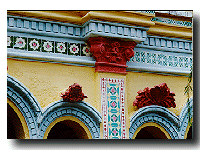 |
The trip lasted about 20 minutes. Next to him, Soy commented that the city was like Bangkok of the mid to late seventies. The skyline was clear of smog or tall buildings; three stories being the uniform standard. All around the mini van, and greatly limiting its speed and maneuverability was a mob of bicycle, moped, and cyclo riders whipping around, risking their lives at every uncontrolled intersection (In fact, it was not until the second day that either of them recalled seeing a traffic light and before the end of the trip, he'd seen at least one traffic accident per day).
Surprisingly, women drivers seemed to be in equal numbers unlike Bangkok in which you'll only see one woman cyclist in 100,000. They peddled or scooted along in their elegant traditional outfits often with one passenger on the handlebars and one on the back of the seat.
(The traditional outfits are quite stereotypically un-Asian. Women wear two pieces. The top, borrowed from Chinese tradition but modified for the Southern heat, is a skintight thin white or blue full-sleeved shirt that extends to just above the waist then splits front and back. The bottoms are often white flowy pants that come from the hill tribe tradition with flaring bottoms. Some women also had elbow length gloves that seemed French in origin. Our guide Hoang noted that ironically, although the outfit officially covered every part of the woman's body, you could actually see everything because of the sexy cut and the thin fabrics used. Of course, Saigon is fairly westernized, so the majority of women did not wear the style.)
Payments made, travel itinerary confirmed, and luggage stored in the hotel, they decided that it would be best to walk into central Saigon by themselves as walking alone would give a unique view of the city that they may not have later.
| Vegies |
|---|
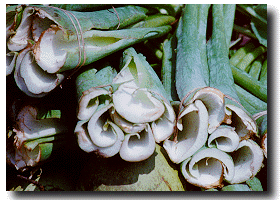 |
And so, he finally knew how the polar bears felt at the Los Angeles Zoo. People strained their necks double-taking and staring so intensely as to be comical. However, most people seemed amazed and interested rather than aggressive or disapproving. Nevertheless, he felt extremely uncomfortable.
Crossing the street was no mean feat either.
The walk was otherwise quite nice. Saigon was laid out fairly well and their map was excellent. They easily found their way downtown where they stopped for diner at the "Lemongrass" a superb restaurant recommended by Ann's Tourist Agency. He had honey-ginger chicken and Soy had a sour seafood soup and a Vietnamese ice coffee. The total bill came to around $15 for both but it was well worth it and quite a bit more interesting than the Pho joints which he frequented in the states.
| Blue on Yellow |
|---|
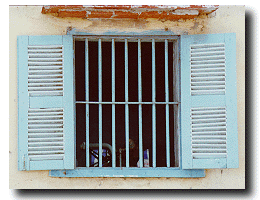 |
He thought about the Pho Gang back in Maryland and drank a silent toast.
After diner, they decided to take a cyclo on a leisurely sunset tour. The cyclo is a three-wheeled bike with a driver in the back and a two-level seat in front for passengers (sometimes 5 or 6!) In the suburb, the bike is sometimes in front. The drivers are spider thin men with stringy long-distance runner physiques. A 45 minute ride cost 3 USD which was probably astronomically more expensive than the going rate but which was just fine. Mike Hines had explained that, "the cyclo drivers are very pesky (VERY) but you can't blame them. They rent the bikes, and a lot of them have 3-6 kids. They rent the bikes for 100,000 per month."
| Vietnamese Design |
|---|
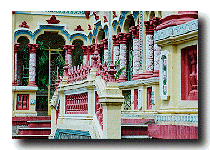 |
Oh, something else. With the exception of fancy restaurants and those catering to foreigners (who are mainly American, Russian and Japanese) the food places provided only miniature chairs and tables as you might see at a kindergarten lunch area. Everyone sat like mealtime low-riders hunched over to reach their food.
On the recommendation of Mike Hines, they made their way to De Tham Street to try out some fruit shakes across the street from Sinh Cafe. He had a strawberry shake and Soy had a Sour Sop shake that Mike had recommended in particular.
De Tham was very much like Khao San Road in Bangkok, a swarm of smelly backpackers coming and going swapping stories, warnings, recommendations, and probably quite a few STDs. It was a jittering way station on the way to more exotic locales around Saigon.
As he sat sipping his fruit shake with enough local ice to assuredly make him sick, he could only think of Marlow's first stop into the heart of darkness. These places were timeless, countriless, sleazy and exciting.
Then there were only empty glasses and yawning.
A cyclo driver instantly whisked them up the moment he took out his map and 2 USD would get them back to their hotel.
As the cyclo driver made his way down cramped alleys and chaotic streets it was clear that Saigon was a front-porch society. Everyone, no let me stress that, EVERYONE was on the street.
| Traffic Flow |
|---|
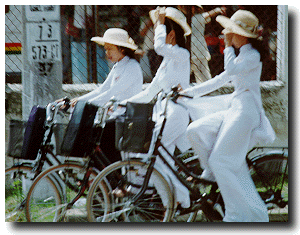 |
A glance above yielded only endless strips of dark and lonely 2nd story apartments. Life after sunset was to be found playing soccer or badminton on the road, in living rooms playing Nintendo with doors wide open to the street, smoking and drinking in groups sitting on those low chairs around the remains of feasts just finished, and just laughing, talking and walking down the sidewalks.
However, exhausted and satiated, they decided to go back to their apartment and get an early night's sleep to be fresh for tomorrows long day.
They were fortunate enough to get a fantastic room at the Haison 2 Hotel near De Tham Street in District One. Their room was in the middle of the building with no window to the street. This was fantastic because as you might imagine, a sidewalk culture is excessively loud at night. The room protected as it was on all sides, was unusually dark, cool and quiet. If you are fortunate enough to find a room empty, you can do no better than to reserve a room with a "2" at the end (202, 302, 402, 502, or 602) at the Haison 2 Hotel. You will be assured a good night's rest.
The next day began quite early. Hoang, their guide, was to meet them in the lobby at 7:30 AM. Indeed, he and the driver Minh were there early. Wanting to make the most of the daylight hours, he and Soy skipped breakfast and hopped into the mini-bus straight away.
| Who Needs Golds? |
|---|
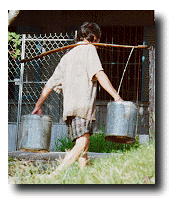 |
The first stop was the "War Crimes Museum" which had recently been renamed from "The American War Crimes Museum" after economic liberalization.
When writing about his experience later, he would find it difficult to express the feelings of guilt, shame and utter embarrassment of having grew up in America. Though as tactful to Americans as the Holocaust Museum in Washington D.C. is to Germans, it was still difficult to see pictures of apple pie-faced American GIs laughing amongst themselves as a Vietnamese farmer crawls off leaving most of his intestines behind.
One room of the museum was dedicated solely to the inhumanly monstrous mutants dead at birth (and worse, those that lived) to victims of Agent Orange. Hoang notes that the refusal of America to fess up to financial support is a bit of a sore spot in the relations between the countries.
| Drying Rice Paper |
|---|
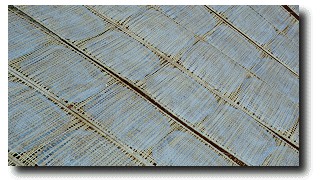 |
However depressing the museum is, it was heartening to note that most Vietnamese under 30 have a more positive yet realistic outlook on the war and tend to welcome Americans with open arms. Much of the pain has been dulled with time and the younger generations seem to have a broader perspective of the war and of Americans in general.
Hoang notes several important factors that they thought were interesting.
- Hoang notes that the fact that Vietnam was able to overcome the U.S. is a
great source of pride. The struggle is viewed more heroically than with
vengeance.
- There is a profound recognition that not all Americans were represented by
the soldiers who came to Vietnam. And more importantly, there were many
soldiers here who seemed to have left good impressions (at least with the South
Vietnamese people I met). Though many were foul brutes representative of all
armies and police forces, many were good people caught in a horrid situation.
The Vietnamese people seem to recognize that.
- The Vietnamese focus more of their negativity towards the French rather than the Americans. Hoang says, the French were leaches who sucked out the lifeblood of the Vietnamese people and returned nothing. At least the Americans provided jobs, built sustainable infrastructure, rebuilt the homes of South Vietnamese allies who'd had there homes demolished in bombings, and gave many people a place to escape to after the war.
At any rate, war and history are more complex than university texts and Oliver Stone would like to admit so it is worthwhile to keep an open mind when getting a better than 3rd hand reports.
| Homework |
|---|
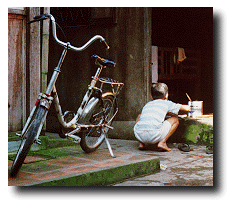 |
After the museum, they were off to the Me Kong Delta. The ride into the suburbs provided a nice pause to stare out the window and just think about war, injustice, the U.S. and the next hundred years. On the other side of the glass, Saigon slipped by, the city transforming into suburb and the suburb devolving into countryside. Rice paddies stretched outward from the road like quilted patchwork divided by thin lines of walkable dry land which stretched out beyond site. Conical-hatted farmers bent low picking and planting and racing to finish their plots before the sun hit its noon apex.
Hoang told him that the strain of rice used in the delta was capable of 3 harvests per year so planting, waiting and harvesting was constant year round. Harvests were exported to other parts of Vietnam, to the rest of South East Asia, and particularly to the soured farmlands of Japan (who have provided vast amounts of agricultural foreign-investment capital).
Minh performed with agility weaving around other motorists and moped riders who dotted the highway in all sorts of chaotic fractals. Horns are used in Vietnam with great frequency. So driving is in fact quite noisy. However, unlike horn blowing in the states, the horn is used as a warning rather than a supplement to the middle finger. The fact is that most roads are small enough that passing bicycles requires moving into the oncoming lanes. A horn lets all know to take care.
Another interesting note is that it is quite common to see men taking a leak on the sidewalks like Barnaby after the third bar. Indeed, there were very few public bathrooms; women travelers beware.
At around 10:30, they were famished and stopped at a roadside stall for a loaf of french bread filled with pork, veggies, and some type of meat spread which he thought was chopped liver. Whatever the case, he was hungry enough to have tried snake and was easily able to hold his nose and down his half of the sandwich.
| Warding off the River Monster |
|---|
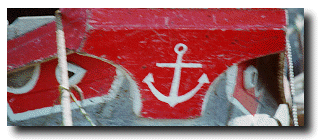 |
And then they were back on the road again.
At My Tho, the gateway city into the Me Kong Delta, they stopped at the snake farm and an old khmer Buddhist monastery; parts of the "official" list of tourist highlights. Both were interesting, made for a couple of choice photos, and were then left behind.
Speaking of snakes, the next arduous encounter was the hoard of small, cute, but vicious waifs hawking food, candy and smokes to travelers waiting in line to catch the ferries across branches of he Me Kong River on the route to Can Tho, the capital of the delta.
They were amazingly persistent, wearing their pitiful faces pressed against his window glass knocking incessantly on the doors to keep his attention. Please please, yes, you buy, you buy. Cum Kam Uh (no thank you). Smiling no, no thanks. Please please, yes, you buy, you buy….
The problem of course was that even if he'd wanted something, he did not dare get it there for fear of attracting even more hawkers. In fact, after the second ferry crossing, he realized, with the advice of Soy and Hoang, that the only way to get them to go away was to totally, and seemingly rudely, ignore them.
Then they would only knock and call for a few minutes.
Another good rule of thumb was to keep money separately available for the beggars who would hit you if you got out of the vehicle. Still feeling bad about the War Museum, he wanted to give some money to the beggars, but was worried about taking out his wad in the midst of all those interested eyes.
| Family Name Shrine |
|---|
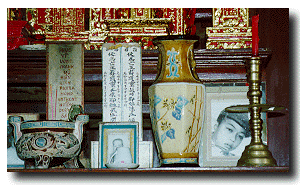 |
Finally they arrived in their hotel, a beautiful open and high ceilinged building on the banks of the Me Kong River. The interior was clean and cool. They dropped off their bags, showered and relaxed for a couple of hours before diner.
With his mind overflowing with recollections from the day, he sat down in his drenched EFF T-shirt slouched over the antique wood writing table
...
Diner was brilliant. They lounged at a riverside candle lit cafe. The meal was superb. He didn't exactly know what he had since he did not choose, but he was unusually brave about food exploration on the trip and was not at all unhappy.
When diner was done, Hoang scored them a boat over to the "Fisherman's Village". Hoang had gotten the tip from a classmate at the Dept. of Tourism at the University who came from the village. She had told Hoang that it was very safe and completely untouristed and provided a very wholesome view of delta life which would be completely unavailable in Can Tho or on any of the regular tourist routes.
In fact, she was quite right.
Stepping off the boat was like crossing the bridge into Brigadoon; a completely separate world full of life, comfort, companionship, family and neighborhood. Children played everywhere in the street and excitedly came up to them in droves saying "Hello", "How are you?" "Where are you from?" and grabbing his hands and clothes. Of course those were absolutely the only meaningful English words they knew so it was pointless to answer, but nevertheless he did.
The adults around had only smiles and nods and though there was a lot of staring, the staring was not quite as discomforting as it was in Can Tho or Saigon.
| Elephant Crossing |
|---|
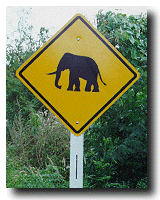 |
So with this perpetual entourage they strolled down the main strand. The village had an odd paradoxical feel.
On the one hand it seemed to him intensely cramped. There were so many people out and about as had been the case in Saigon. Further, the distance between houses was very small. Five steps would have taken him from a living room on one side of the street to a living room on the other side.
Further awnings and second stories gave a draped, tunnel-like ambience.
However, every single living room was wide open to the street. One could easily see most of the rooms in each house. And people seemed to go in and out as if all was part of the road. This gave the opposite feel of vast openness.
So the village was both stuffy and spacious at once.
| Soy in a Boat |
|---|
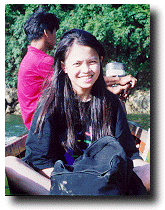 |
Fortunately, the "farmers" who are really fisherman and day laborers in Can Tho did not seem to feel as if he and Soy were invading their private time. Perhaps it was because every single person they met thought that Soy was Vietnamese so it was two Vietnamese and one foreigner. Perhaps that was not as offensive.
In fact throughout the entire trip, Soy's ability to blend in was a continual source of enjoyment for Hoang who watched every single local speak Vietnamese to Soy who would just say "I don't know" and look to Hoang for help. Hoang would then tell the local that Soy was not Vietnamese and the local would sit for 5 or 6 seconds shaking his/her head and say the equivalent of "no fucking way! She looks exactly like a local".
Before returning to Can Tho, he provided a final bit of entertainment when a woman dropped a bucket of fish and he attempted to help her collect them. It took two tries before he discovered that he would have to grab it above the gills if he was to hold the fish as it squirmed away. When he looked up, the old woman had already caught the other fish and was enjoying his show with others around.
Saturday was another early day. Because he could only take off two workdays, they'd been forced to limit their trip to four days and three nights. This meant that every bit of daylight was to be used if possible. In fact, the great efficiency of Hoang was another benefit of Ann's Tourist Agency. They did not need to worry about queues, bus rides, map reading or anything else that might slow them down.
| Nintendo |
|---|
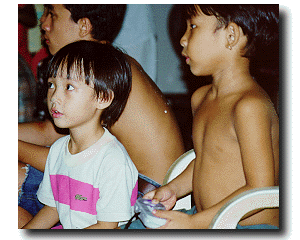 |
The majority of the day was to be spent boating up the Mekong River and exploring the various canals and waterways that had opened up because of the recent passing of the rainy season.
Perhaps it was because all good cybogs have difficulty discerning between cinema and meatspace or perhaps it was because his only socialization to Vietnam was Apocolypse Now. But, it was difficult for him to stop referencing and comparing what he saw to what he'd seen.
Every time they passed a mango grove he thought of Frenchy sprinting out of the jungle screaming, "Tiger".
Actually, there are no large animals since they have all been eaten. Even the poisonous snakes that did present some concern for getting off the boat were more common in the wok than in the rushes at the riverbank. Most of the wildlife consisted of kids swimming and laying at the banks and the occasional boat on its way to the market.
All the while was the socio-cultural background soundtrack of Hoang with his vast knowledge of Vietnamese culture and history. No question went unanswered and most questions opened up entire areas of discussion as answers usually involved politics, history, economics, etc….
The first stop on the river was the floating market. The floating market in the Me Kong delta was quite a bit different from the one outside of Bangkok. This one is the real thing. No trinkets were sold. No T-shirts saying Planet Hollywood Saigon were sold. Instead, fruits, vegetables, and other goods of interest to locals were sold between hundreds of small and large boats which congregated in one area while they waited for the river's tide to calm for their continued journey downstream.
In fact, this floating market is not for tourists at all but for the people themselves. In our five-person boat we were easily able to slip into the heart of the market and slowly cut through looking at all the available agriculture. For a quick scan, one could easily look to the poles that shot skywards from most boats and hung samples of available products for sale. Hoang also pointed out the huge ceramic jars on some of the houseboats that he explained held fresh rainwater.
| Monkey Bridge |
|---|
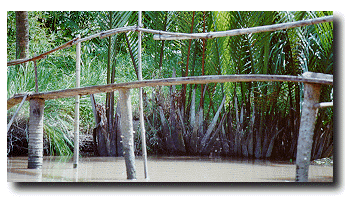 |
After the floating market they headed up into the smaller canals which provided a complex vein-like network through the delta.
After about 30 minutes of sun bathing and lounging they reached their next stop, the monkey bridge. The monkey bridge were two vertically parallel strips of bamboo-sized poles that led over the canal. Hoang told them that they would be stopping for lunch soon and that if they wanted, they could get off and cross the monkey bridge and meet the boat further up river.
Of course they chose the gymnastic route and had lots of fun inching their way across while a group of locals hung around waiting for the slapstick to begin. Unfortunately for them, he and Soy made it across with no difficulty.
They left the boat with its big round eyes painted on the underside to scare off the river monster to make its way up to the next stop alone. Meanwhile, they walked up onto the road that cut between the river on one side and an expanse of rice paddies on the other.
| Monkey Soy |
|---|
 |
Hoang led the way to a small farm he knew of where the owners allowed people to walk through their fruit and vegetable gardens and have lunch while they were showed various locally-produced handicrafts.
Yes, they did choose to buy something and though similar items were available at cheaper prices in the city, the money seemed more like a tip since it was the boat driver who was selling the stuff.
After lunch, it was time to head back to Can Tho, eat diner, and make the long drive back to Saigon.
Sunburned and sleepy, he leaned back and just watched it all go by.
On the drive back, he took some time out to catch up on the journal he was keeping that he would type in and make available on the web as usual next week. He also helped Soy edit some work that she'd brought with her. Actually, it was very interesting material as she was currently studying the effects of a possible merger between the two competing cable television service providers in Bangkok. The situation was a complex web of political, economic and social intrigue that was a fascinating supplement to a great book he was reading called "The Lords of the Rim" that focussed on Chinese emigration out of South China and the silent but powerful oversea economic empire that had been built out of the emigrants.
Since he could say the words "bandwidth' and "fiber optic" in context during the discussion, you can imagine that he was a happy cyberian.
They arrived in Saigon just in time for diner. For diner, they returned to De Tham Street and got a hot tip about a river boat cruise which left at 8PM and toured the Saigon River for an hour with food and live bands on three levels. They went without delay.
| Surprise! |
|---|
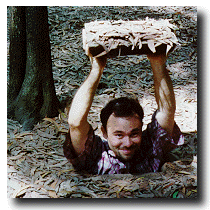 |
It turned out to be very nice. The fare was 70 cents and the meals averaged around 3 USD/person.
Although the bands by themselves were fairly awful, the lowest level hosted Chinese karaoke which if taken in moderation was quiet a good time. Drunken and aged Mandarin tourists howled to pop Chinese music in notes that could only exist on some twenty-note scale from Mars. However far from being grueling to watch, the karaoke was a blast. He thought that he would greatly recommend that anyone staying in Saigon overnight head over to the Saigon riverfront and catch one of the diner boat trips.
The next was spent crawling through the tunnels in the suburb of Cu Chi. Cu Chi was an essential strategic area to control during the Vietnam War because it was a buffer between Saigon and the Viet Cong headquarters near the border of Cambodia. Whoever had control of the area could launch attacks at the heart of their enemy.
Needless to say, the Vietnamese controlled the area throughout the war even though the Americans used every means they could to wrest control including mass bombings, tunnel rats, dogs chemical warfare and anything else they could use.
Initially constructed during the French resistance, the Cu Chi tunnels carved out of the clay soil with hand shovels provided dozens of miles in three levels of safe underground transportation to freedom fighters.
| A Tunnel Rat |
|---|
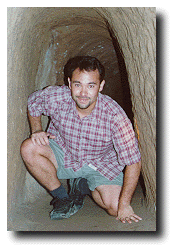 |
The network is extensive and amazing though extremely hot when crawling through the bowels.
The tour of the Cu Chi tunnels began with a documentary about the Vietnam War, the history of the tunnels and the role the tunnels played in the war. Next was a demonstration of the incredibly diverse and intelligent booby-traps which were set for American soldiers throughout the area and discussions of the guerilla techniques employed by the Viet Cong soldiers.
Finally, the tour guide led them through the maze of tunnels underneath the complex that had been preserved. Much of the tunnel system has now collapsed or has been taken over by dangerous animals and snakes. However, the Vietnamese maintain several sights which are safe for tourists including a more touristed tunnel complex that has been cemented over and widened for broad - shouldered westerners and the tunnel complex where Hoang took them that was left in its original state.
It was earie to wind through the tunnels in near blackness crouched over and twisiting around and around and up and down.
Finally it was time to head to the airport and finish writing while they waited for their respective planes back to their countries.